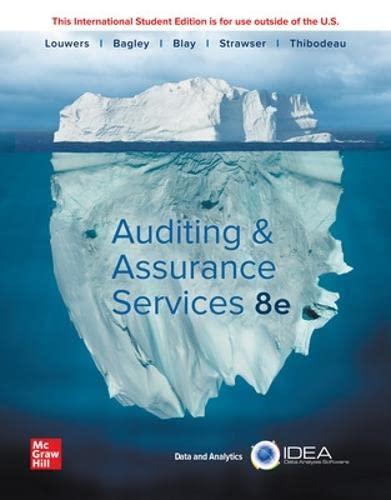Question
1. Avril Company makes collections on sales according to the following schedule: 40% in the month of sale 56% in the month following sale 4%
1.
| Avril Company makes collections on sales according to the following schedule: |
|
40% in the month of sale |
| 56% in the month following sale |
| 4% in the second month following sale |
| The following sales have been are expected: |
| Expected Sales | |
| January | $150,000 |
| February | $170,000 |
| March | $160,000 |
| Budgeted cash collections in March should be budgeted to be: |
a. $160,000
b. $159,200
c. $165,200
d. $160,600 2.
| Vandel Inc. bases its selling and administrative expense budget on budgeted unit sales. The sales budget shows 1,900 units are planned to be sold in April. The variable selling and administrative expense is $4.80 per unit. The budgeted fixed selling and administrative expense is $35,690 per month, which includes depreciation of $3,400 per month. The remainder of the fixed selling and administrative expense represents current cash flows. The cash disbursements for selling and administrative expense on the April selling and administrative expense budget should be: |
a. 44,810
b. 41,410
c. 32,290
d. 9,120 3.
| Laurey Inc. is working on its cash budget for May. The budgeted beginning cash balance is $35,000. Budgeted cash receipts total $116,000 and budgeted cash disbursements total $110,000. The desired ending cash balance is $51,500. To attain its desired ending cash balance for May, the company needs to borrow: |
a. $92,500
b. $0
c. $51,500
d. $10,500 4.
| Mitchell Company had the following budgeted sales for the first half of next year: |
| Cash Sales | Credit Sales | |
| January | $40,000 | $140,000 |
| February | $45,000 | $160,000 |
| March | $47,000 | $120,000 |
| April | $52,000 | $147,000 |
| May | $62,000 | $190,000 |
| June | $70,000 | $370,000 |
| The company is in the process of preparing a cash budget and must determine the expected cash collections by month. To this end, the following information has been assembled: |
| Collections on credit sales: |
| 30% in month of sales |
| 35% in month of following sales |
| 35.0% in second month following sales |
| Assume that the accounts receivable balance on January 1 was $87,000. Of this amount, $70,000 represented uncollected December sales and $17,000 represented uncollected November sales. Given these data, the total cash collected during January would be: |
a. $207,000
b. $199,000
c. $134,000
d. $100,000 5.
| Richards Corporation had the following budgeted sales for the first half of next year: |
| Cash Sales | Credit Sales | |
| January | $60,000 | $160,000 |
| February | $65,000 | $180,000 |
| March | $33,000 | $140,000 |
| April | $38,000 | $133,000 |
| May | $48,000 | $210,000 |
| June | $90,000 | $230,000 |
| The company is in the process of preparing a cash budget and must determine the expected cash collections by month. To this end, the following information has been assembled: |
| Collections on credit sales: |
| 50% in month of sales |
| 40% in month of following sales |
| 10% in second month following sales |
| The accounts receivable balance on January 1 is $63,000. Of this amount, $48,000 represents uncollected December sales and $15,000 represents uncollected November sales. |
| What is the budgeted accounts receivable balance on May 30? |
a. $48,000
b. $105,000
c. $166,300
d. $118,300
Step by Step Solution
There are 3 Steps involved in it
Step: 1

Get Instant Access to Expert-Tailored Solutions
See step-by-step solutions with expert insights and AI powered tools for academic success
Step: 2

Step: 3

Ace Your Homework with AI
Get the answers you need in no time with our AI-driven, step-by-step assistance
Get Started


